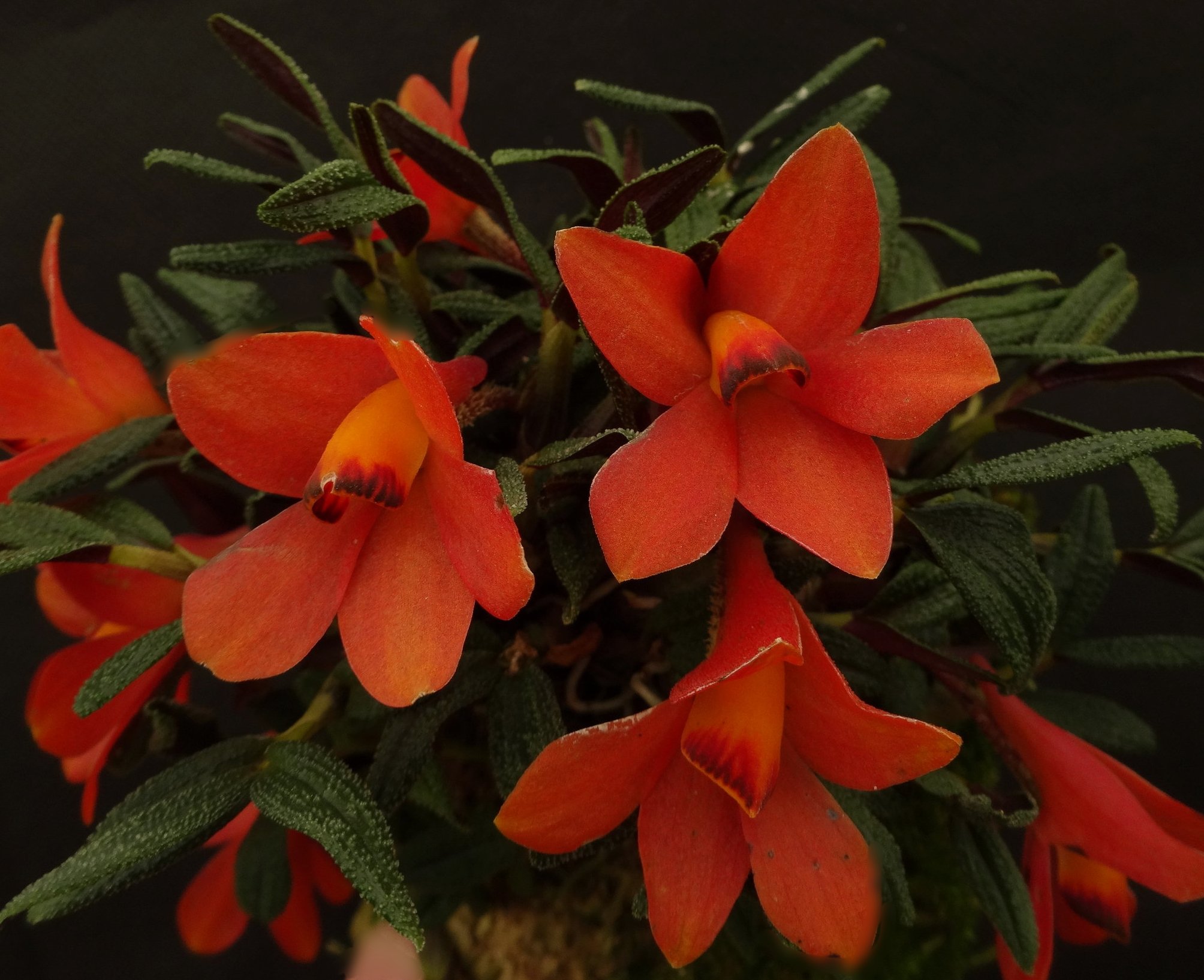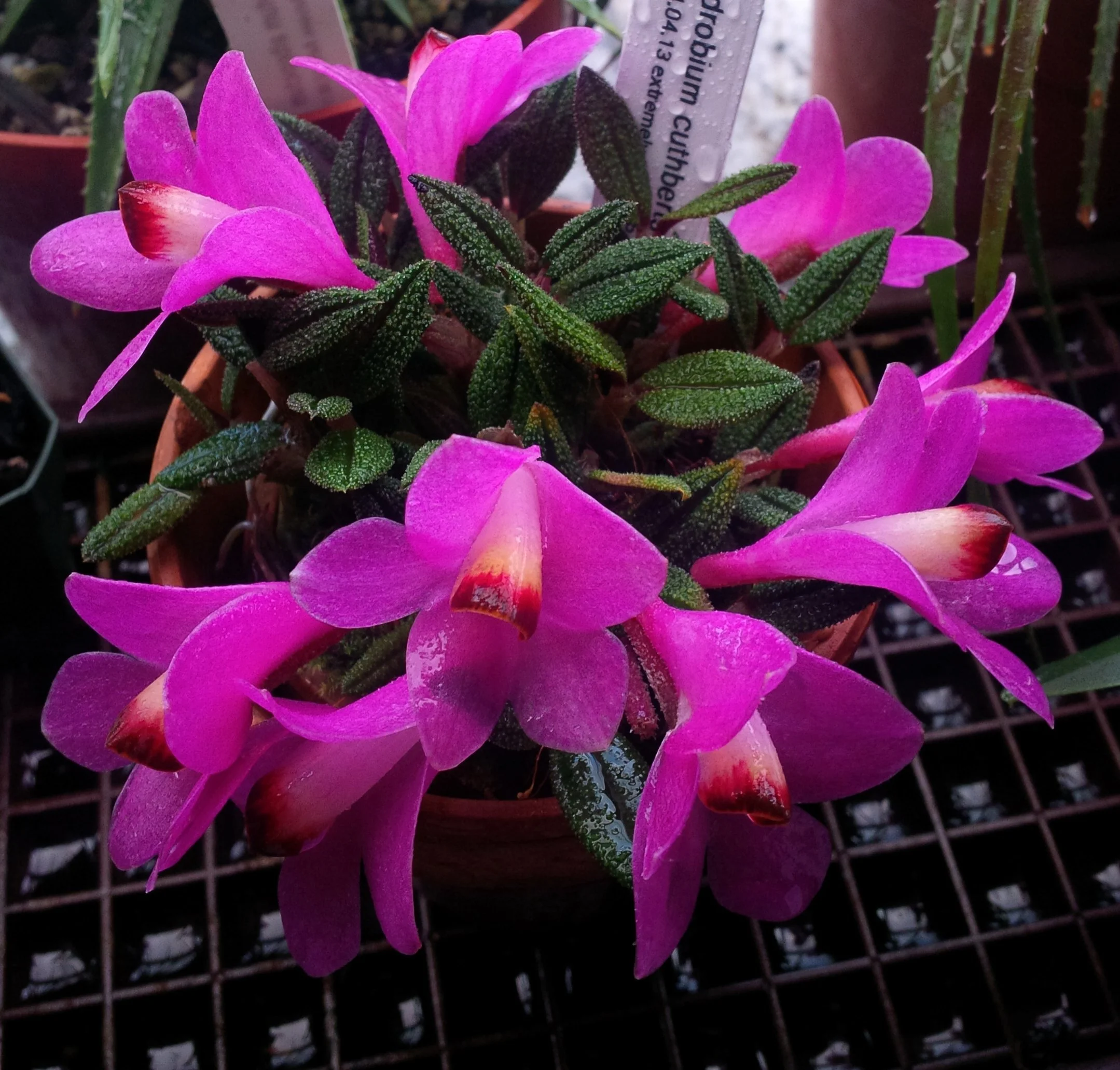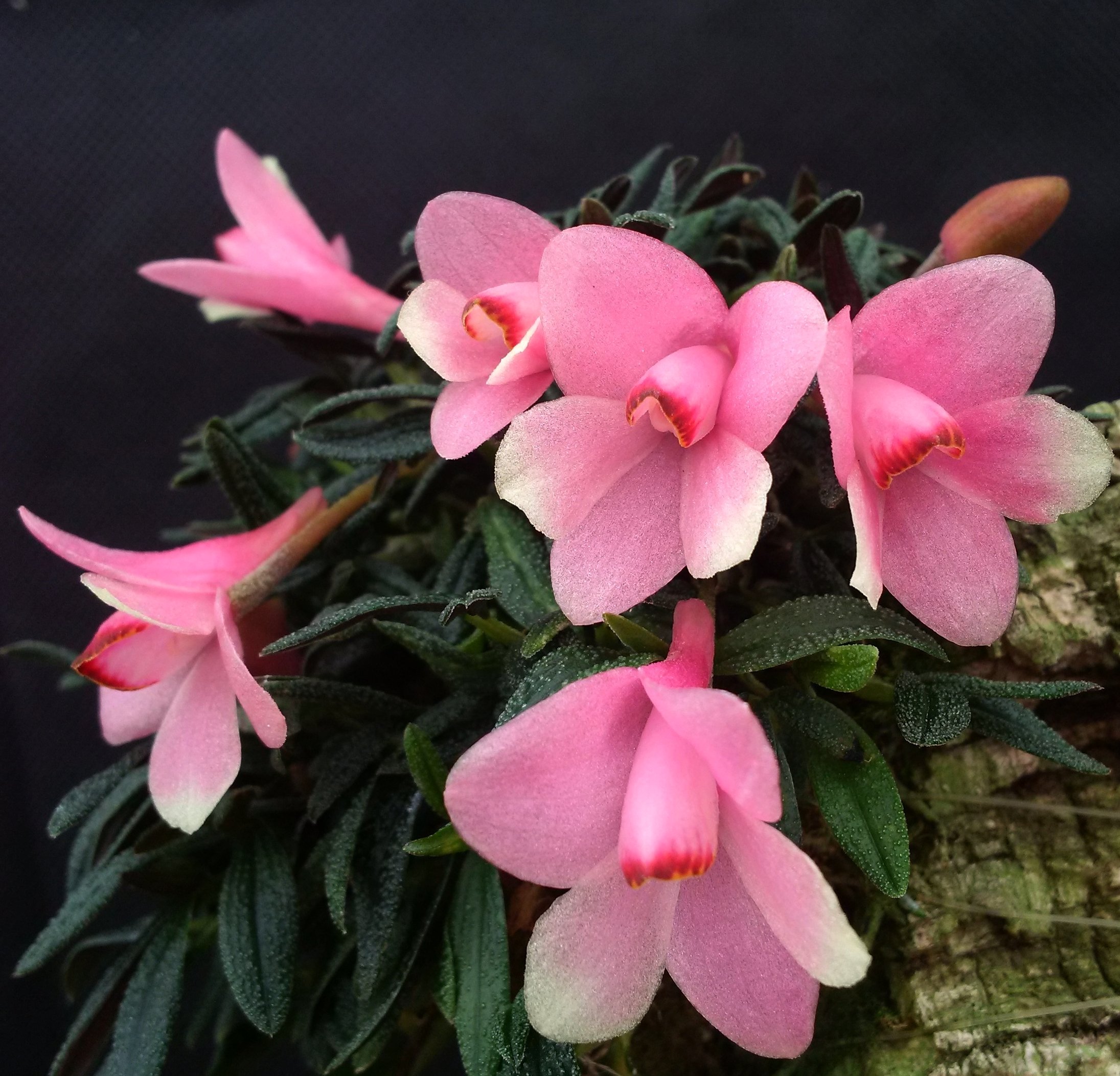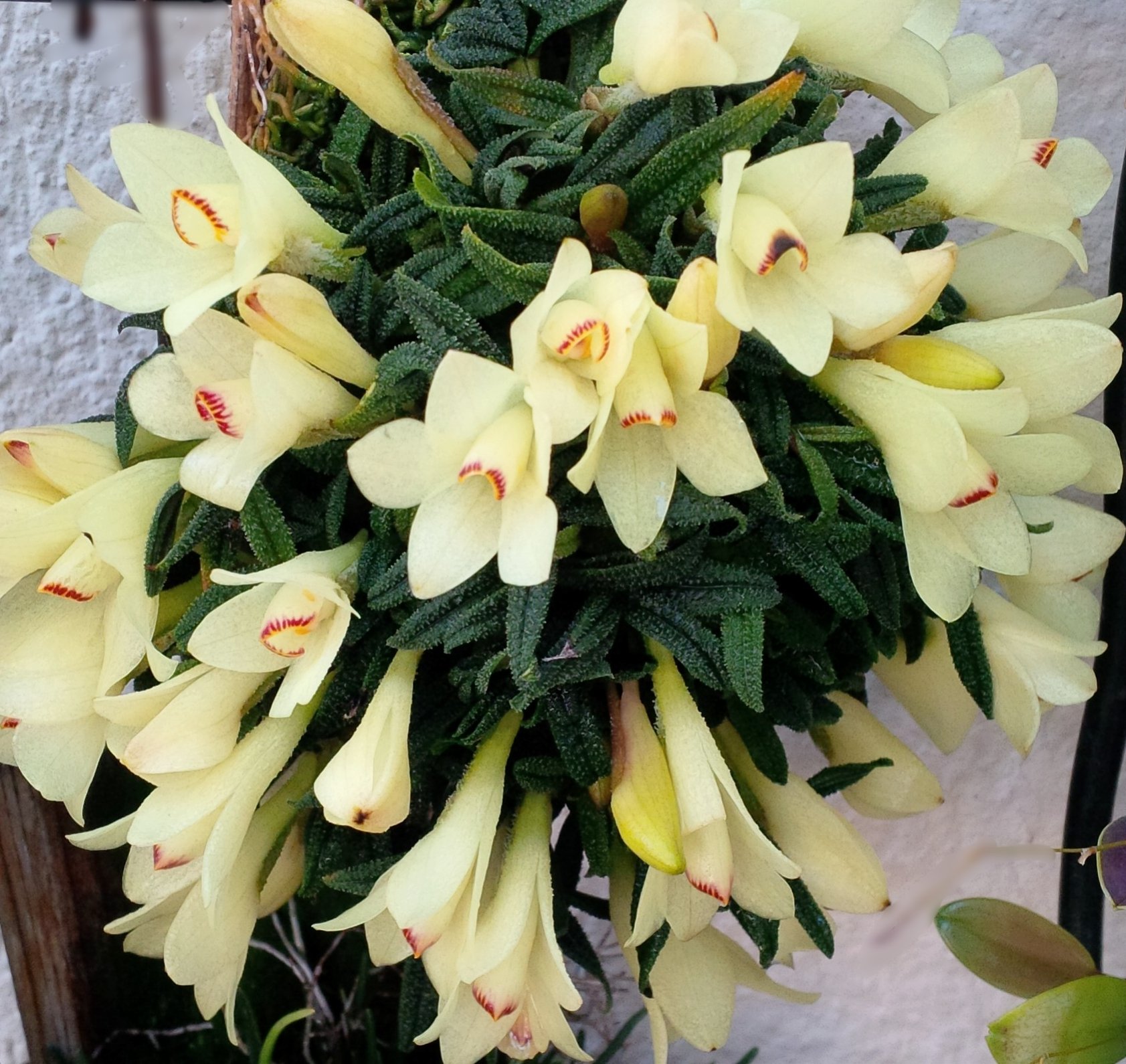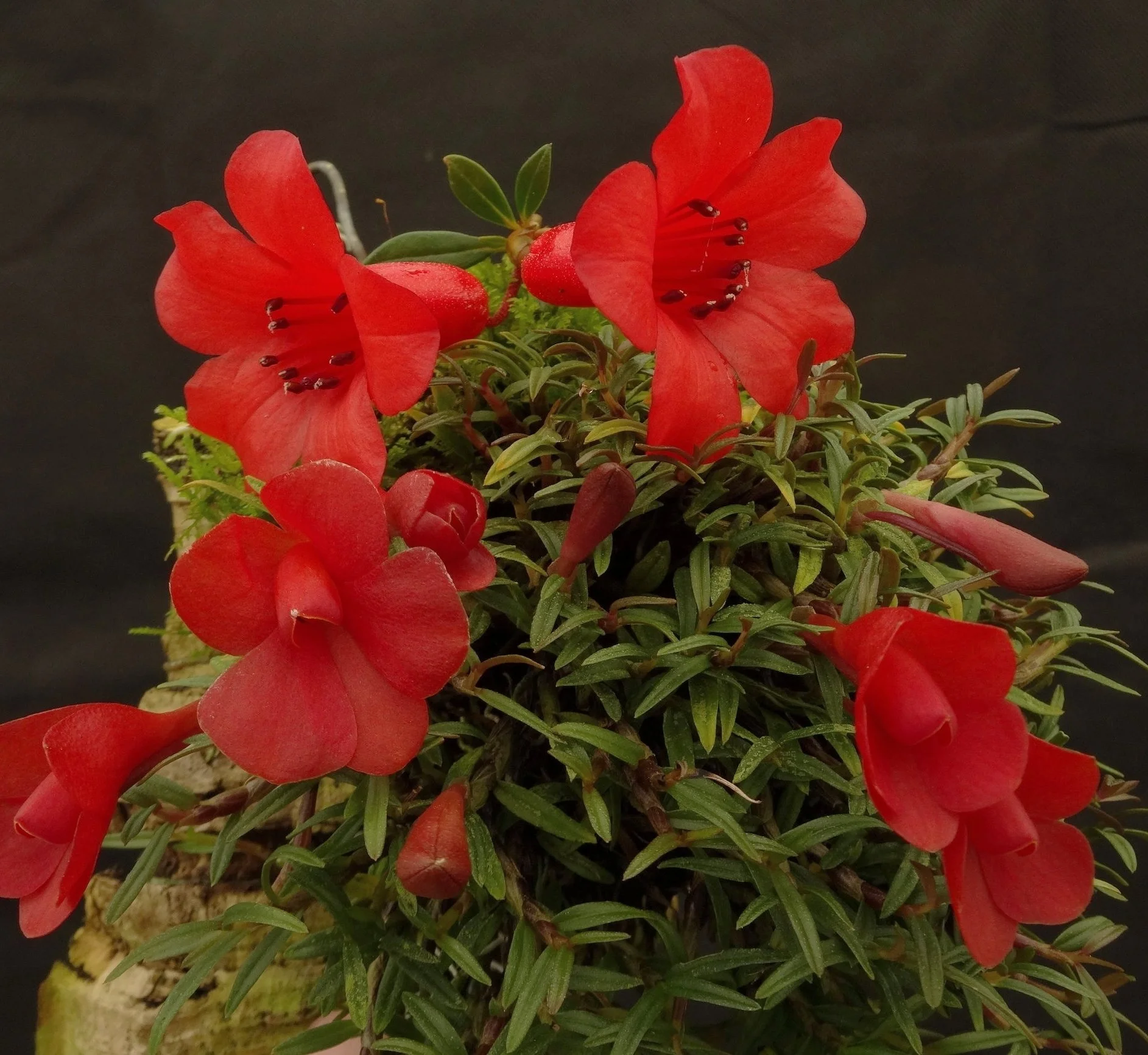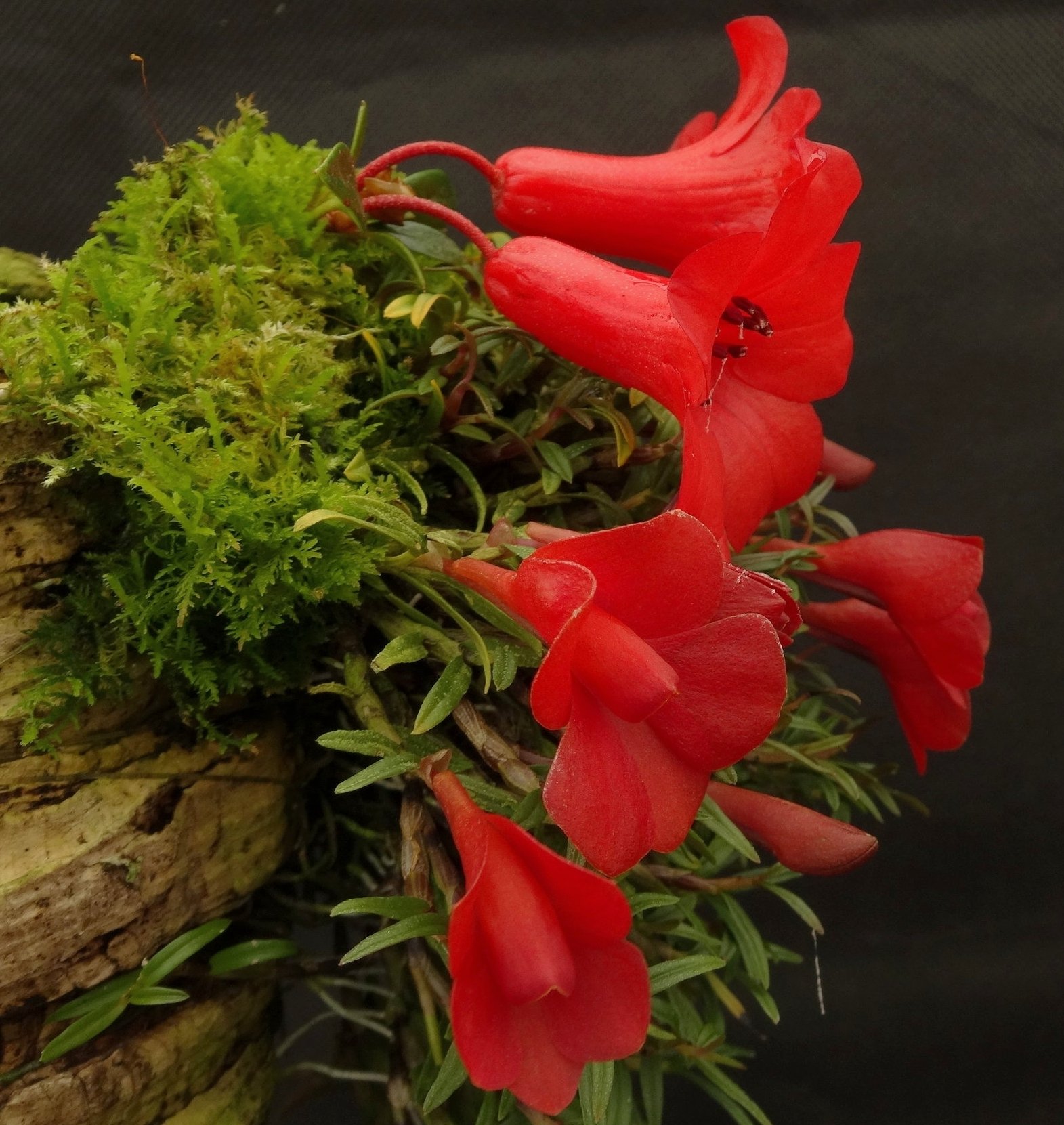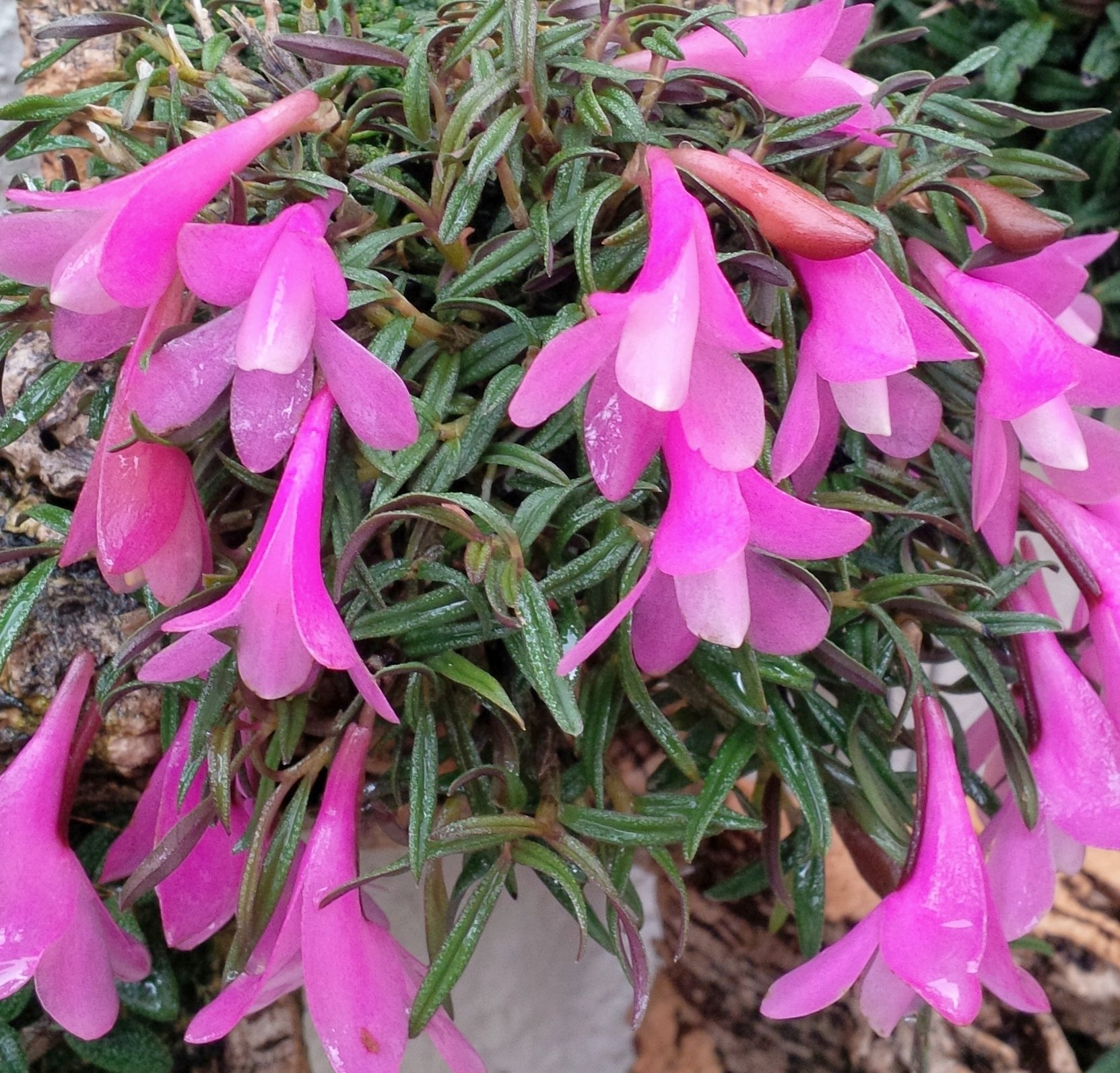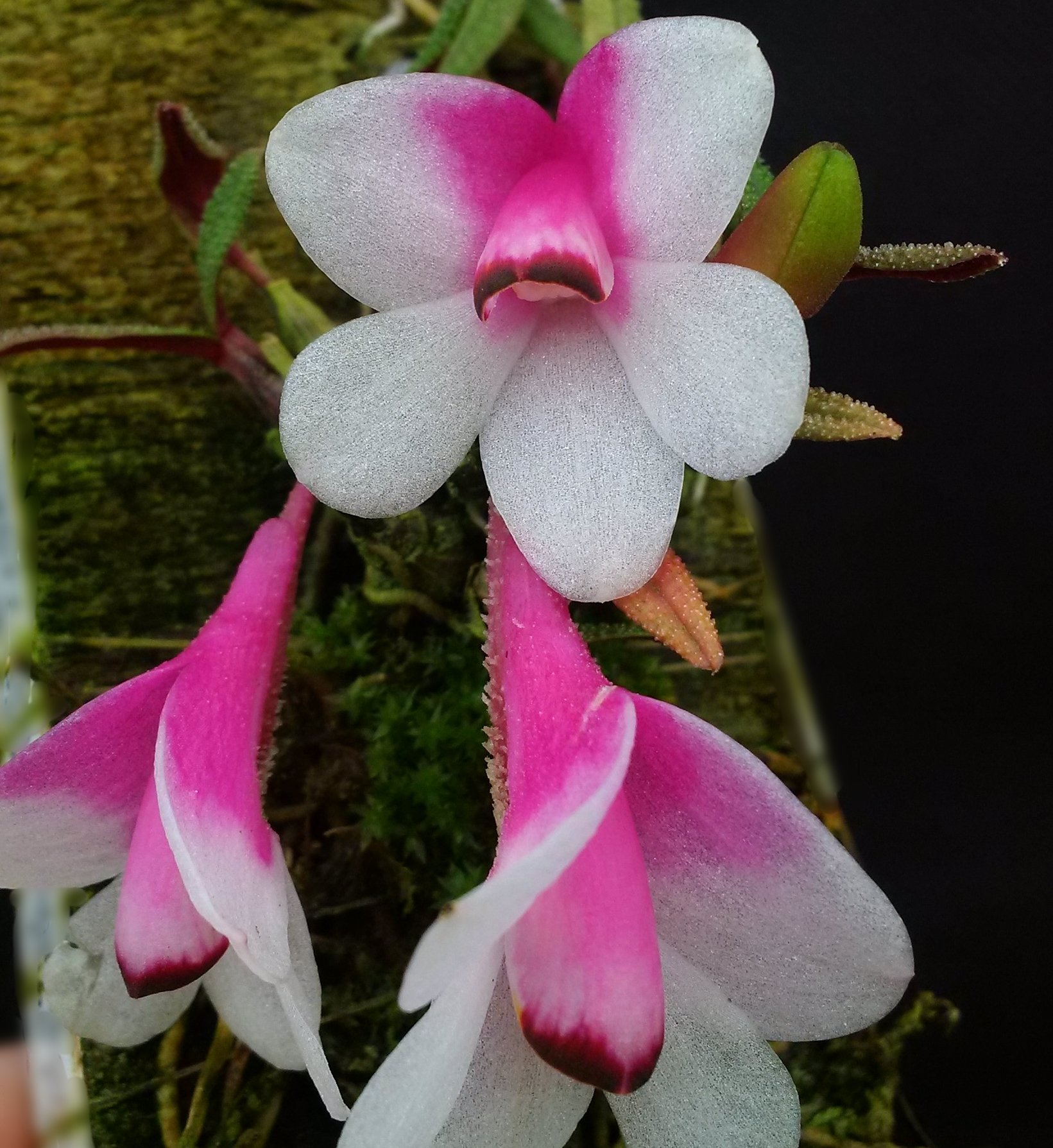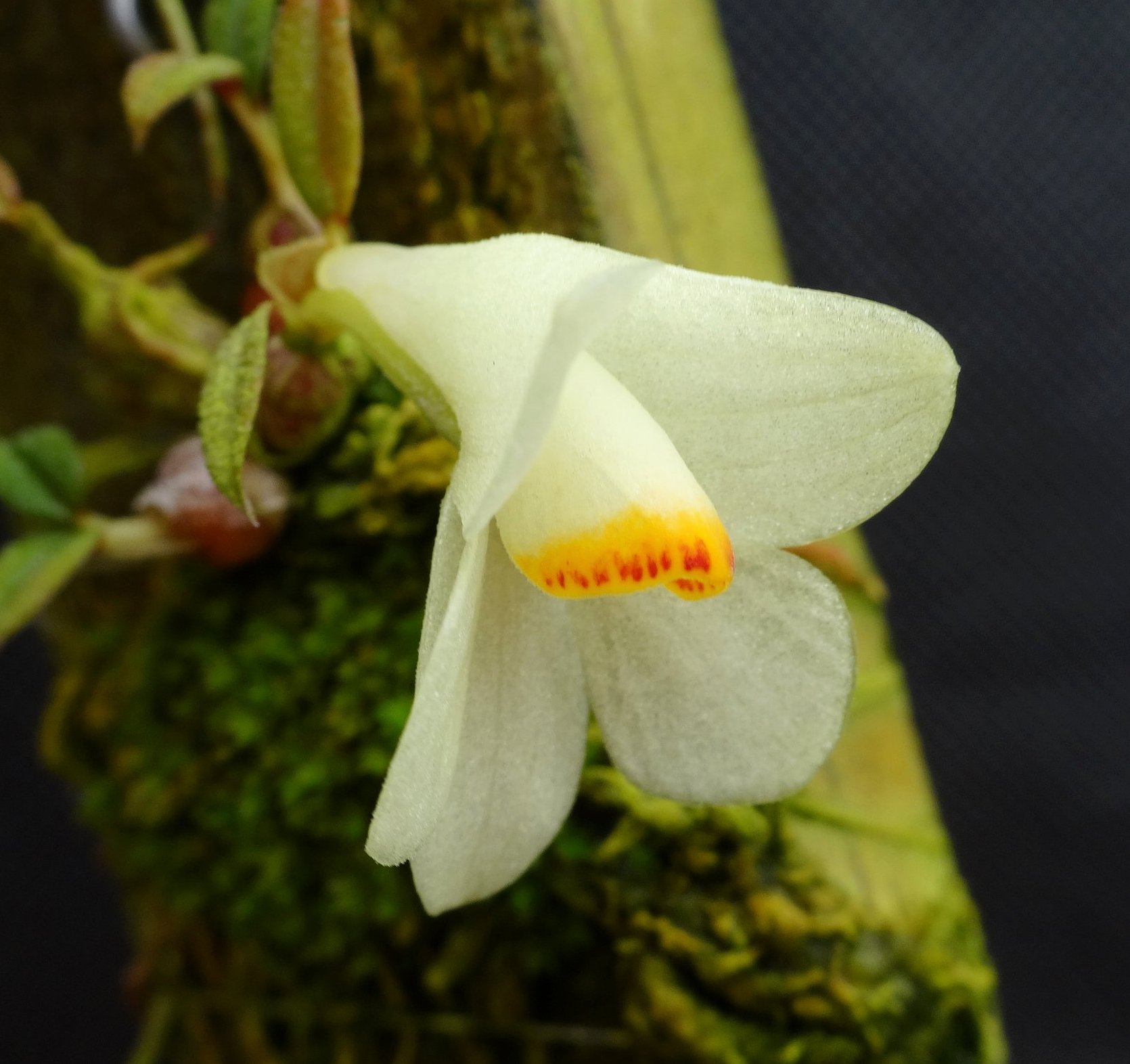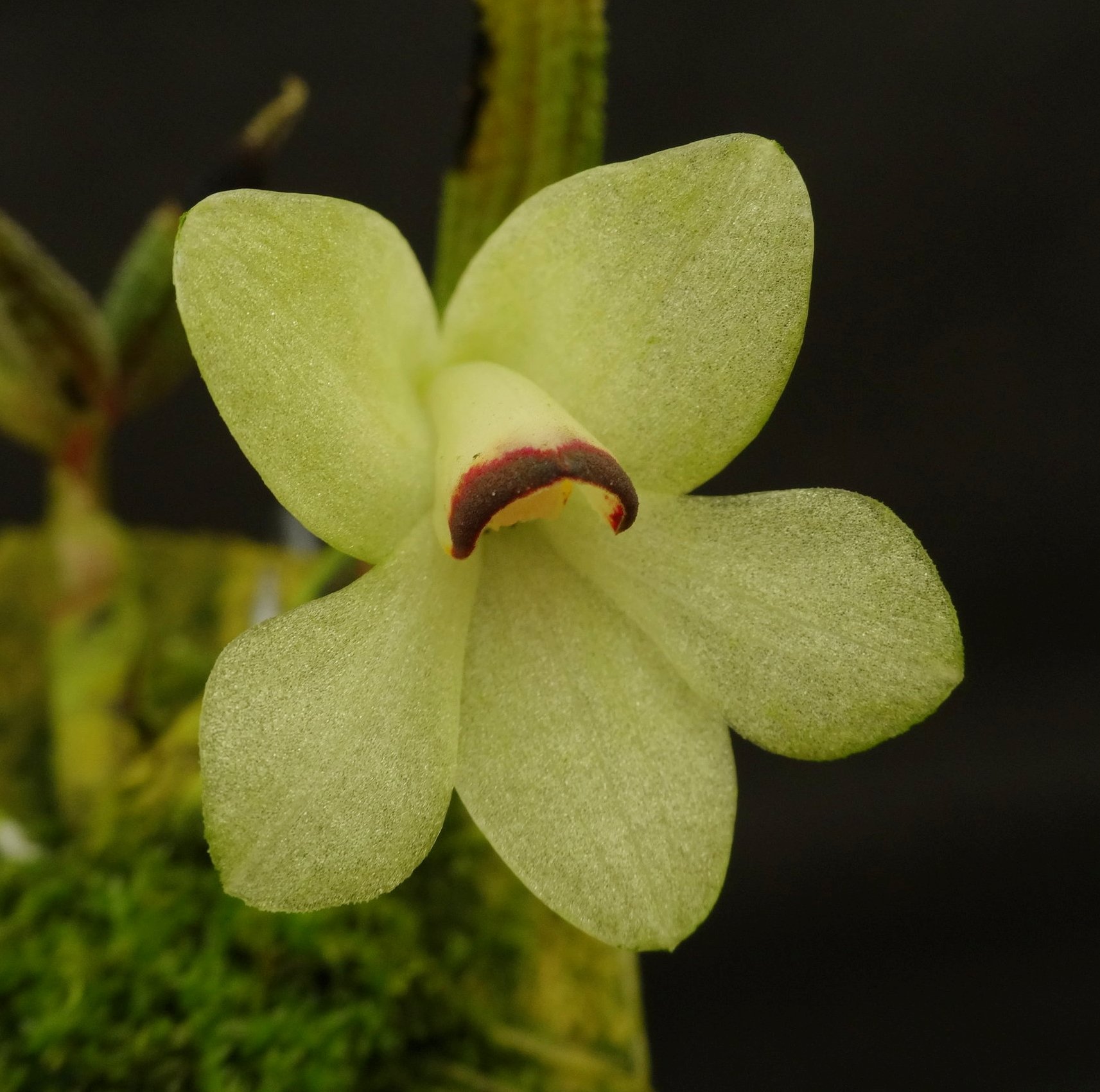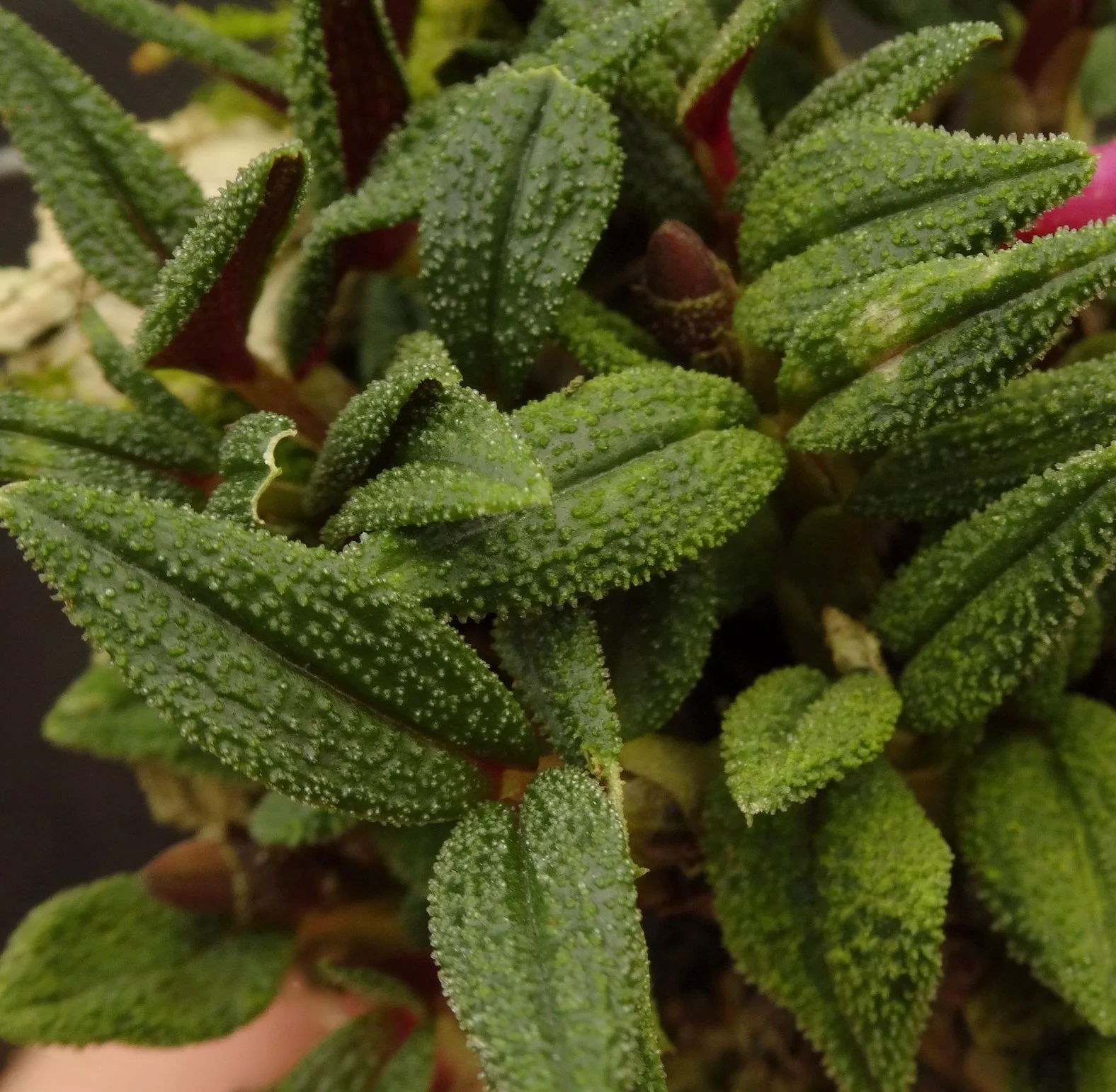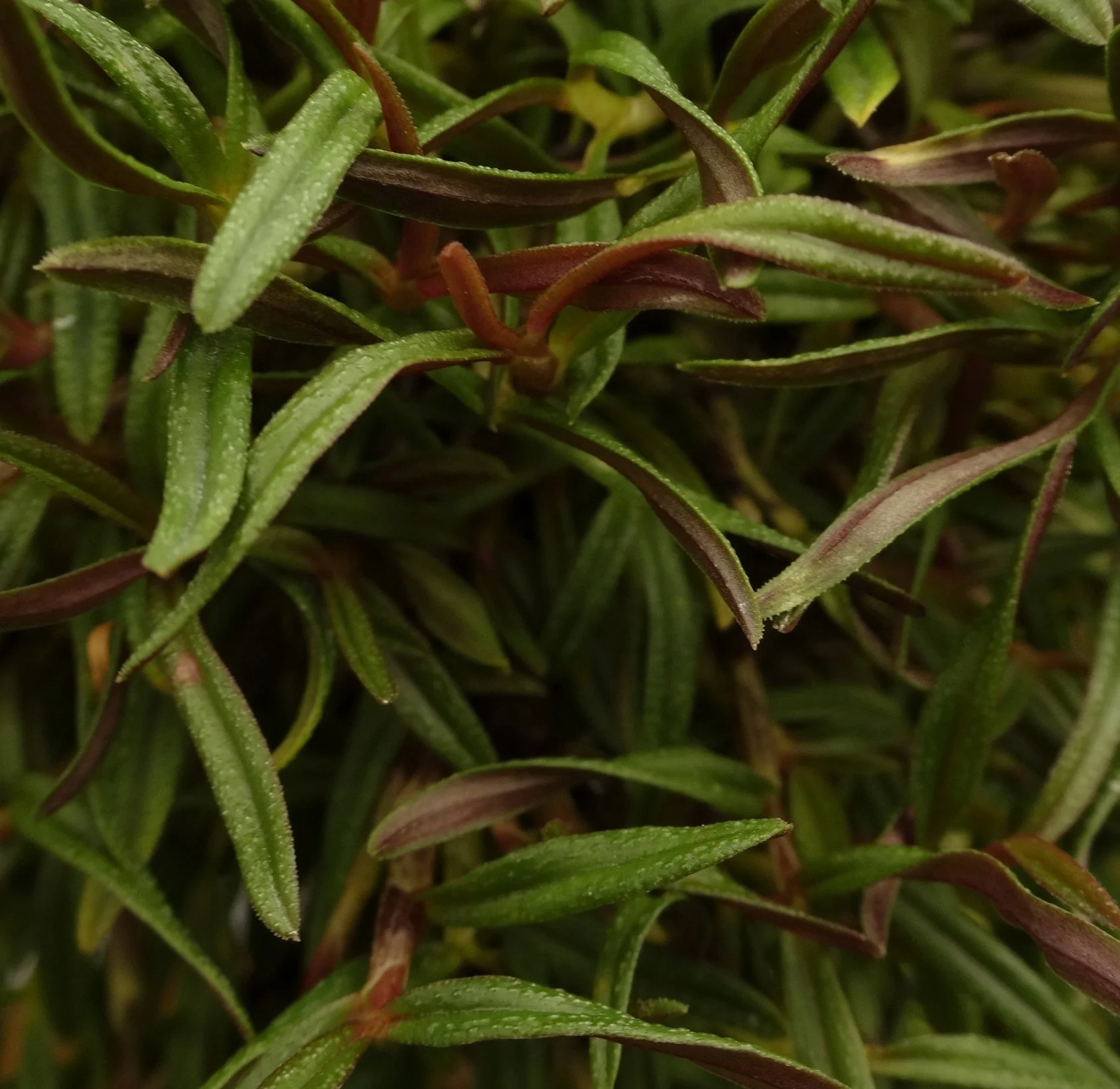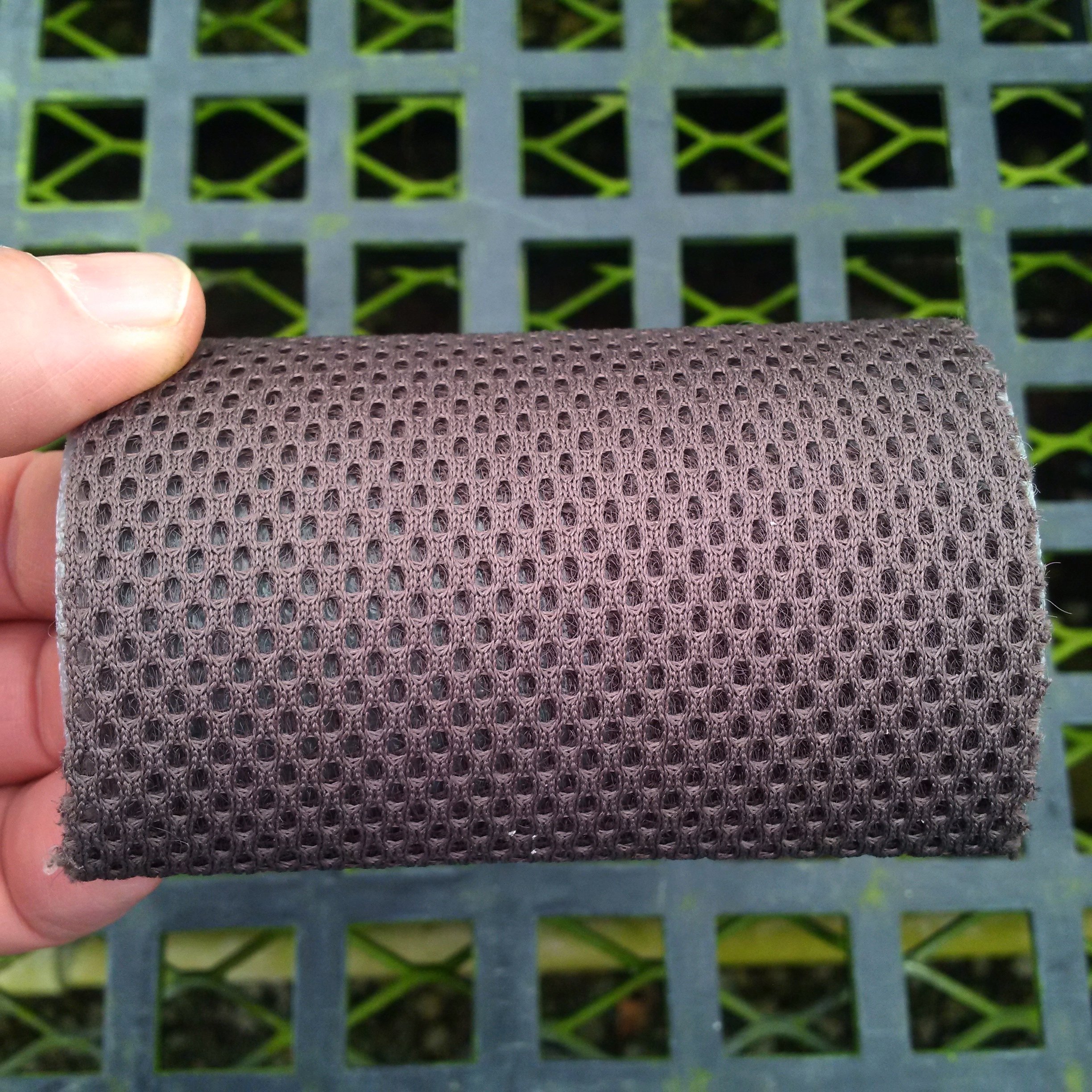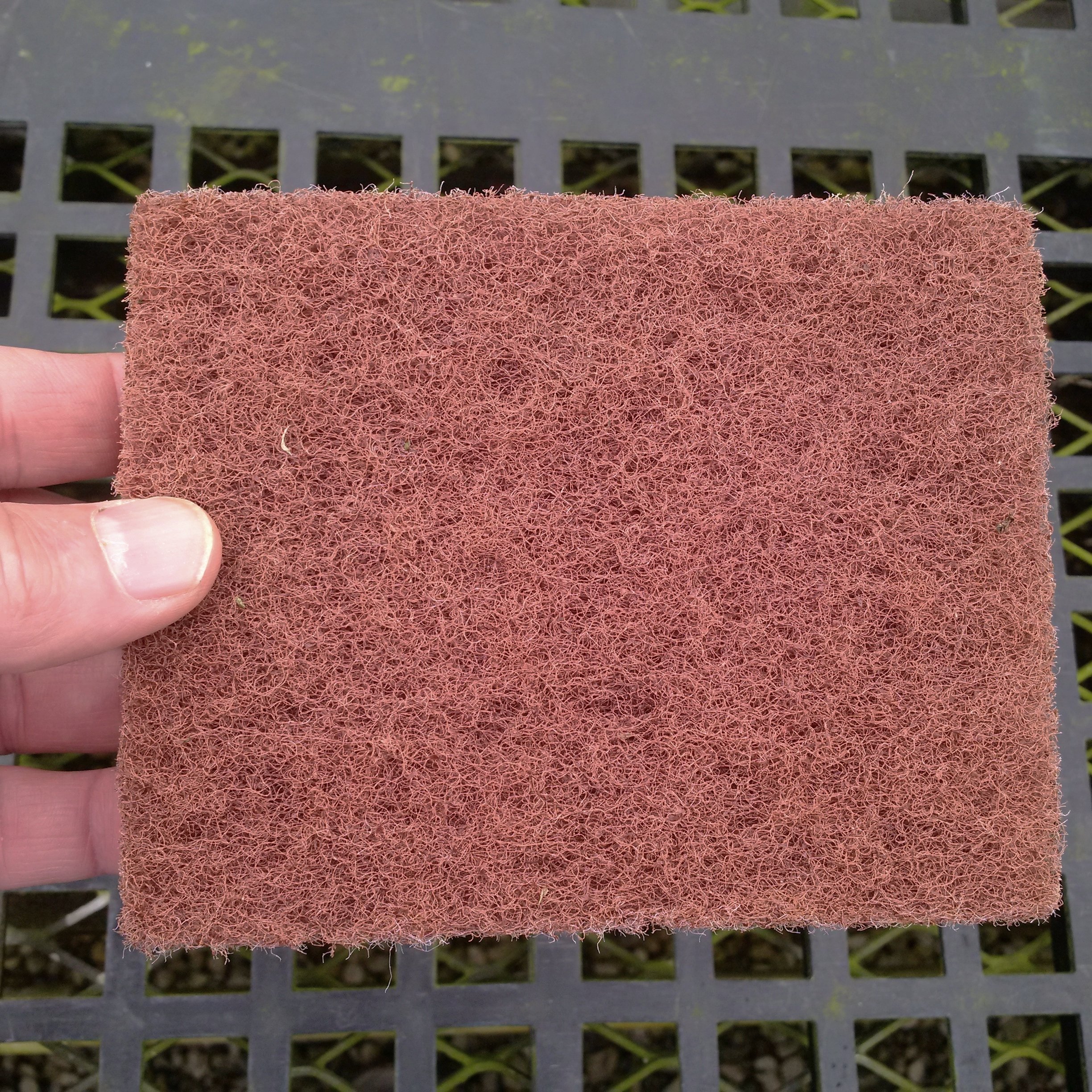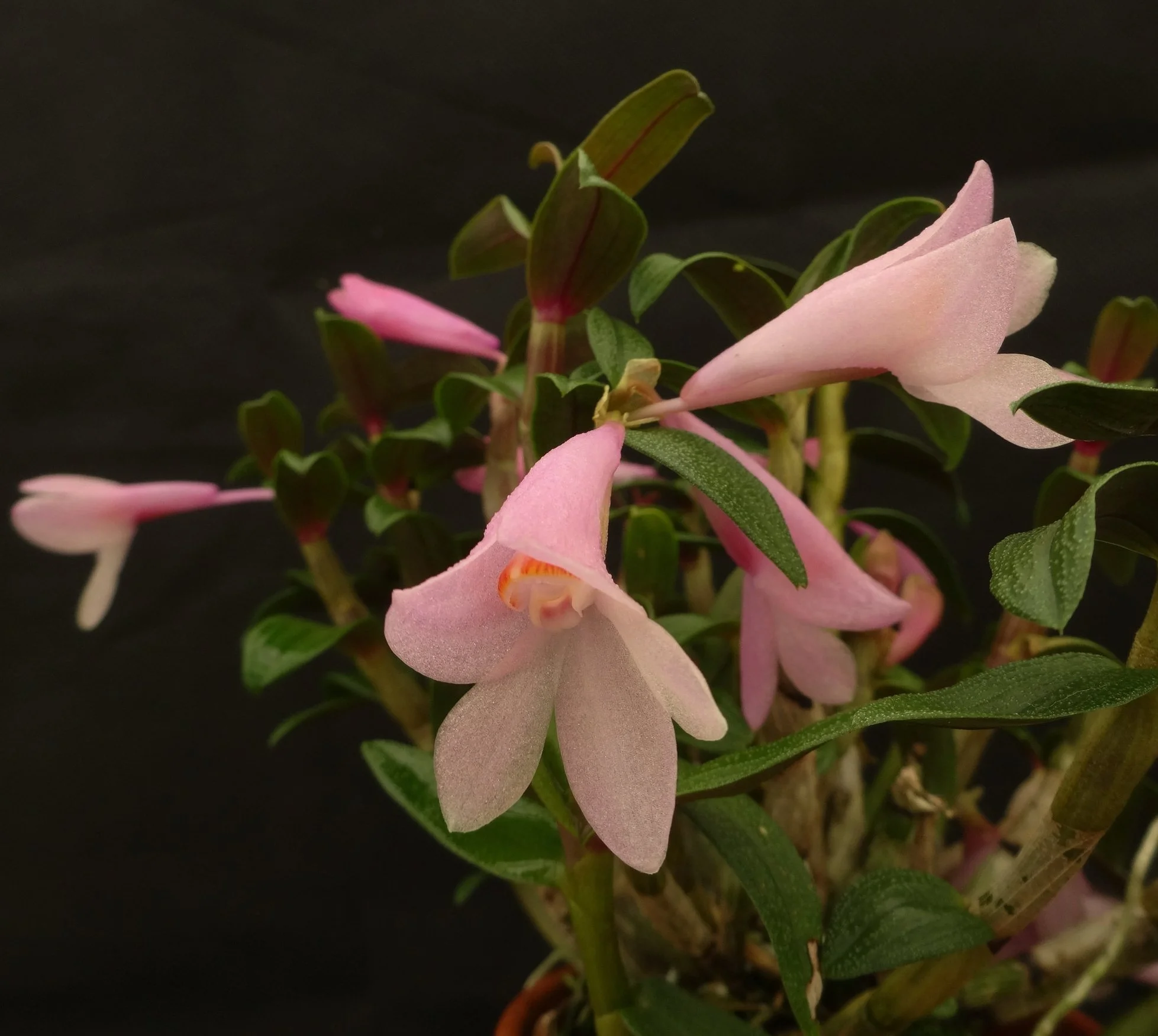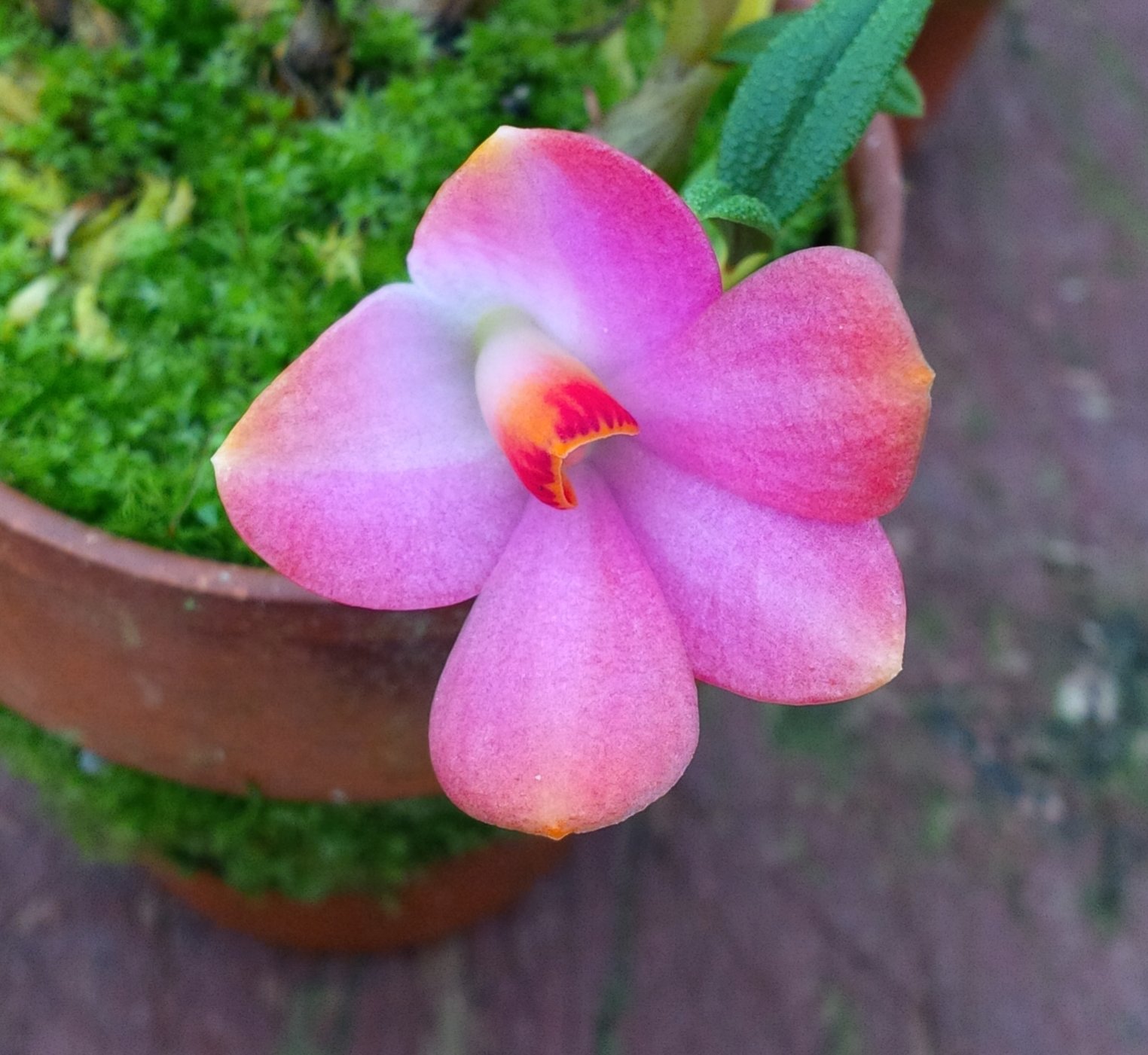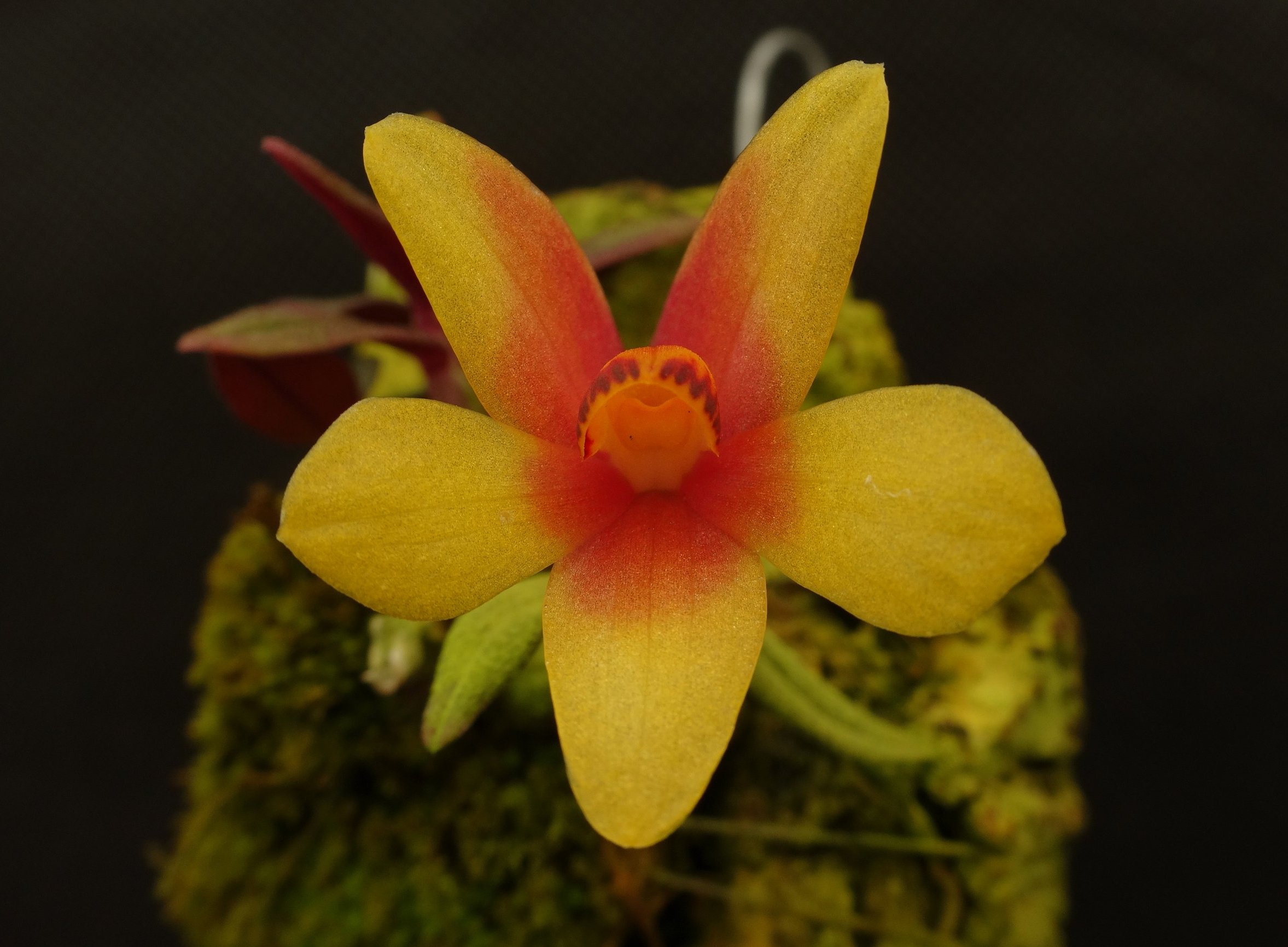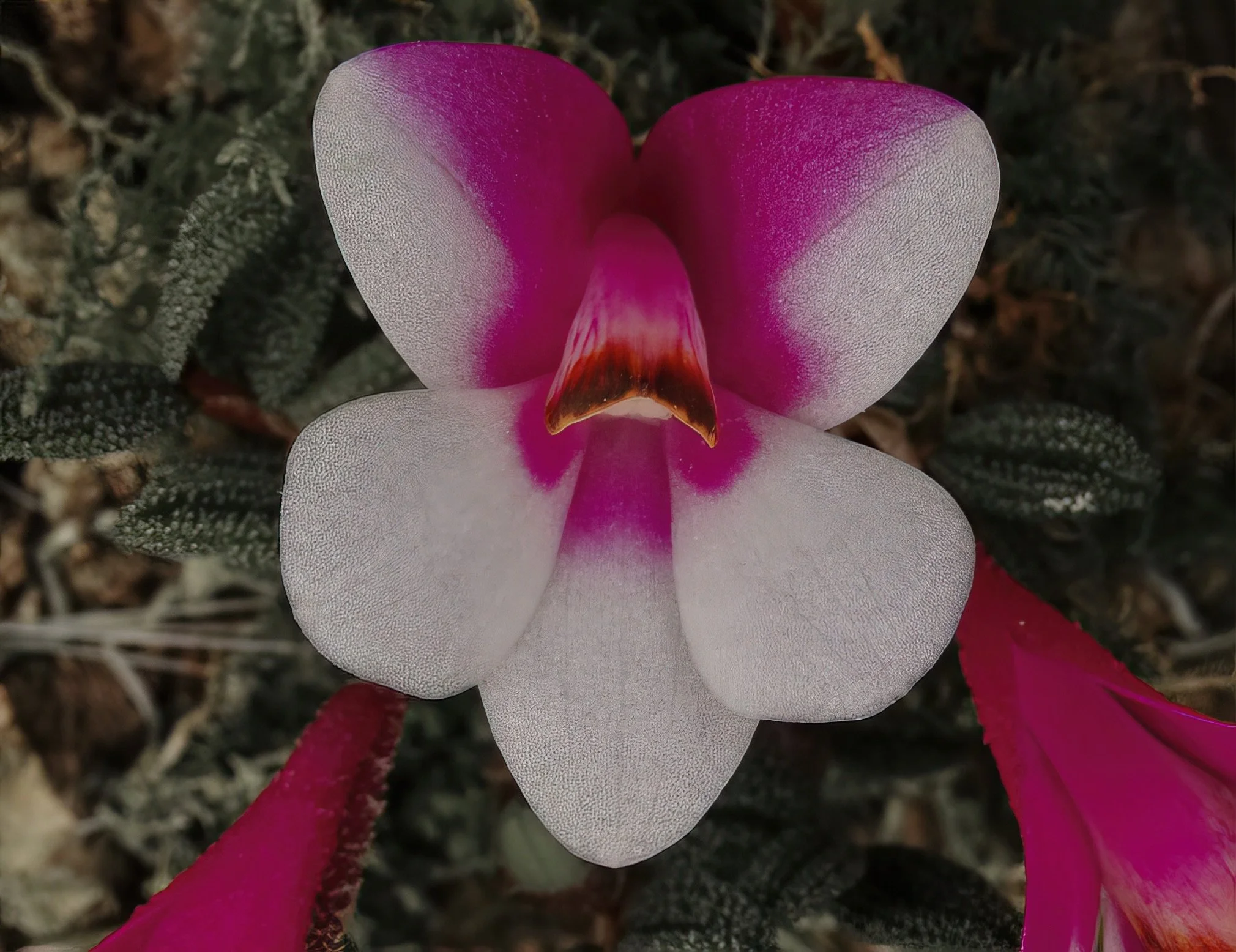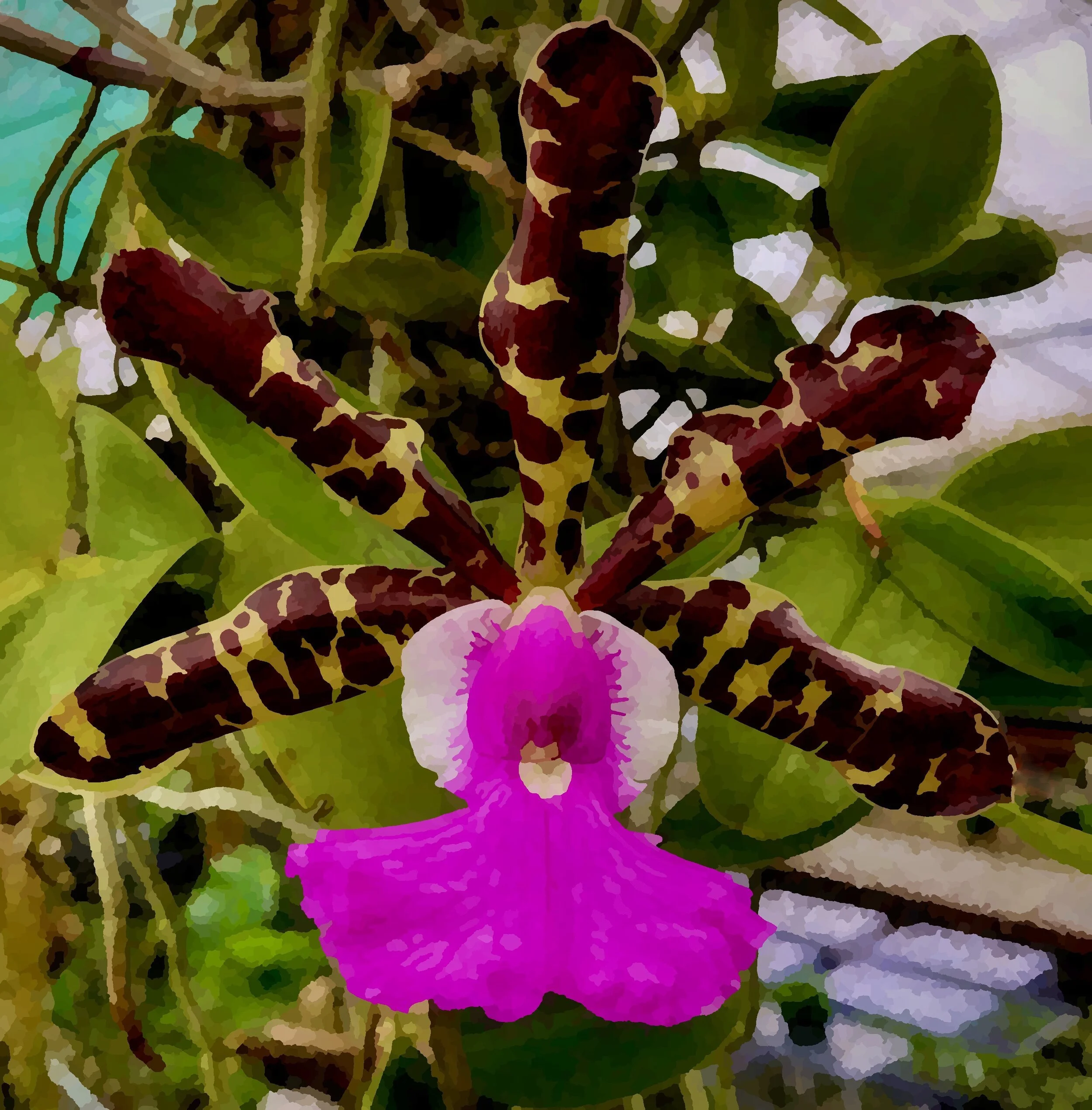Dendrobium cuthbertsonii and other Killer Pygmies from New Guinea
Dendrobium cuthbertsonii, a highland gem
by Jay Vannini
Dendrobium cuthbertsonii is probably the most famous and certainly one of the most desirable New Guinea orchids in cultivation. Its diminutive plant size coupled with relatively huge and showy flowers ranging in color from pure white through clear yellow, orange and red to deep purple as well as bicolored forms, makes it extremely striking when well-grown. This species, together with another very attractive New Guinea endemic, D. lawesii, are also noteworthy for being the world's two most color variable orchid species. Casual observations I have made at plant shows where it was offered for sale indicate that it has great traffic-stopping appeal even to non-orchid growers; something quite remarkable for a miniature. While many plant collectors have tried and – for a wide variety of reasons - failed with this beauty, it is reasonably straightforward in cultivation if the improved planting material now available is used and several of its quirks are addressed by the grower from the outset. That said, it is not an orchid that I would recommend to beginners nor those who cannot attend to its needs. It is definitely a species that will test a grower's talent when maintained over the long run, but is worth every bit of effort to try and grow it to perfection. A robust, well-flowered specimen plant is perhaps the most worthwhile achievement in miniature orchid culture.
(Click on images below to view slideshows)
There is an enormous amount of information and misinformation on this species posted on the internet. Some of it will contradict statements and recommendations made here. My current growing practices are the product of interaction with people who have successfully cultivated large numbers this species, some for decades. I have been quite fortunate in knowing and corresponding with two of the most talented growers and breeders of this species (Tom Perlite and Darrin Norton) for some time. I have managed to grow a number of color forms to fairly large sizes over the past seven years - fully exposed to the elements outdoors in coastal central California for the most part - while losing only a few small plants in the process. I am also acquainted with several other individuals who grow this species at a very high level of culture and believe that over the years I have benefited from all of my correspondents' experiences and recommendations.
Dendrobium laevifolium, very nice clone (GGO)
This species was discovered by the English plant collector Walter Cuthbertson in 1887 in what was then British New Guinea and described by his colleague, the famed botanist Ferdinand Heinrich von Mueller, a year later in the Transactions and Proceedings of the Royal Society of Victoria (Australia). It has more than a dozen synonyms, the best known of which are Dendrobium agathodaemonis, D. sophronites and D. lichenicola. Currently, none of these are recognized as valid by WCSP/The Plant List, but D. agathodaemonis is still in wide use among species orchid growers. Growers who defend the validity of this name will invariably identify D. agathodaemonis plants as having elongated stems with narrow, nearly smooth leaves and fruits, coupled with flowers whose lip lacks the characteristic dark margin seen in most D. cuthbertsonii clones in cultivation. Sidestepping the debate a bit, I favor using the term "agathodaemonis-type" plants to identify this usually distinctive material from most D. cuthbertsonii forms in cultivation. Commonly still considered part of Sect. Oxyglossum, more recent unpublished work by botanists associated with Hortus Botanicus Leiden now place these dendrobiums back in the larger Sect. Calyptrochilus. Its closest relatives appear to be D. laevifolium, also from New Guinea and islands to the east, and D. prasinum from Fiji. Widespread in occurrence, D. cuthbertsonii has been collected across the uplands of both Papua New Guinea (PNG) from the Bismarck Archipelago in the east, the D’Entrecasteaux in the southeast, through north central Indonesian Papua Province (IP) to the Tambrauw Regency in the west. While usually considered to be strictly an upper elevation plant with records as high as 3,500 m (~11,400’), there are also populations that occur at fairly low elevations (800 m/~2,600’) in western IP. Individual plants may grow epiphytically, as lithophytes or as terrestrials and moss companions.
Dendrobium prasinum flowering at Golden Gate Orchids.
They are almost certainly pollinated primarily by birds such as honeyeaters (Meliphagidae) and black sunbirds (Leptocoma aspasia - Nectariinidae), as well as other opportunistic nectar feeders that are attracted to pink, red and orange tubular flowers. There are unpublished reports cited on the internet of observations made by visiting birders of honeyeaters gleaning D. cuthbertsonii at localities in eastern PNG. Several authors have suggested that because D. cuthbertsonii has opted to forego a nectar reward it has evolved a complex “deception” mimicry model via floral polychromatism and vegetative polymorphism to entice birds, repetitively, to its flowers, particularly those that are known to visit the sympatric orange, red and pink-flowered species of vireya rhododendrons (Rhododendron spp., Ericaceae). Epiphytic and terrestrial vireyas are abundant and conspicuous members of the flora of the New Guinea highlands and reportedly outnumber D. cuthbertsonii by many multiples at any given locality. Several red-flowered species of PNG natives, such as R. gracilentum, R. rubellum and R. rhodostomum, have flowers that are visually very similar to those of many D. cuthbertsonii. The prevailing - and highly plausible, in my opinion - hypothesis is that the remarkable variation in flower color and leaf form among individual D. cuthbertsonii plants living in proximity in habitat minimizes the risk that their sympatric bird pollinators could learn to recognize the fraud and, hence, avoid their reward-free flowers. This strategy would tend to favor the survival of plants carrying genes for multiple flower colors and leaf forms, thus the extreme morphological variability of this orchid. Presumably, the same evolutionary pressures produced a nearly identical result in D. lawesii and other related species, albeit generally at lower elevations. Old World nectivorous birds lack the ability to hover, so bird pollinated flowers must be situated on or immediately adjacent to a convenient perch for regular pollination to occur. In the SF Bay Area, native hummingbirds routinely visit and occasionally pollinate flowering D. cuthbertsonii grown outdoors, so it is evident that they are visually attractive to some birds even off their home grounds.
The images below show the amazing resemblance in size, color and flower shape between Dendrobium cuthbertsonii 'Ron's Red' (aka 'All Red'), a very nice "agathodaemonis" wild type plant and Rhododendron 'St Valentine', a primary hybrid of NE Queensland and Papua New Guinea miniature red-flowered cloud forest vireyas. Note also the appearance and size of the leaves on the terminal whorl of the vireya.
I started tinkering with this species in California in 2011 after seeing some very fine ones in flower for sale that year at the San Francisco Orchid Society’s Fall (now Summer) “Orchids in the Park” show. After starting them in a sunny bay window for a few months, I decided to trial them outside to a very bright but semi sheltered spot on my deck. Except for a few indoor interludes due to freezing overnight temperatures, most of my plants were grown under these conditions year-round for the next six years. Over this time-frame what were originally small starts in 2”/5cm pots have grown into some of the fairly large specimen plants shown in this post. The decision to move them from outdoors culture to cool greenhouse was prompted by their increased value (to me) and several heat waves we experienced in this area during late spring 2017, where we experienced daytime highs of over 105 degrees F (>40 C) and nighttime lows in the 80s F (~29 C). This type of temperature regimen, coupled with very low humidity, are not really favorable for the survival of this species so into the cool house they went.
(Click on images below to view slideshow)
The flowers of this species are famous for being very long-lasting when conditions are near optimal. While there are claims of them lasting nearly a year, my experience has been that six to seven months is a more reasonable lifespan for most D. cuthbertsonii blooms. The plants will flower year-round, usually peaking in the late summer and fall in this area. Smaller plants may benefit from flower removal in winter. Despite this practice being Gospel for some, I have never bothered and my plants have always grown fairly vigorously. I do agree that one should remove flowers from visibly struggling plants to avoid “death-by-flowering”. Note: flowers will promptly blast when exposed to very high temperatures without near constant misting, full afternoon summer sunshine, or if the plant is dried out too long.
(Click on image below)
Another of the very attractive features of this plant are the leaves on some forms, which are fairly succulent with both upper surfaces and seed pods micro-papillose/tuberculate in texture. While this type of leaf is a somewhat unusual characteristic on an orchid, a number of pleurothallids and bulbophyllums also share this feature. Tuberculate leaves serve the dual purpose of increasing light capture in cloudy or shady habitats and facilitates shedding rainwater to keep leaves from being perpetually wet in cool montane rainforests. In some of the darker-flowered forms the leaves will show a deep green tinged with violet, particularly on the lower surfaces. This is another modification to increase light capture in shaded, montane forest habitat. Under optimal conditions the leaves will persist on the pseudobulbs for many years, eventually forming a very dense mat of foliage on larger plants. Some plants (agathodaemonis-type) have elongated pseudobulbs and long, smooth or barely rugose leaves. Based on observations made some time back by a friend of a box of imported plants originating from IP, there can be visible intergradation between the two extreme leaf forms visible in plants vegetatively propagated from field-collected material.
From recent correspondence and conversations with orchid collectors who have cultivated this species for decades, it appears that D. cuthbertsonii has been in limited, but apparently continual, cultivation among specialist collectors in the U.S. for about 50 years. Both its mention and a color image included in the first edition of Rebecca Tyson Northen's "Miniature Orchids and How to Grow Them" (1980 - an orange flowered form as D. sophronites) provides evidence that they were commercially available in the 'States by the time the book was written. The first significant modern D. cuthbertsonii introductions in the US seem to have been made separately in the early 1970s by the well-known orchid collectors, Walter Teague, and Dr. Ernest Katler, both of whom had traveled in the highlands of PNG to observe this species in habitat. Ernest Katler crossed the creamy white semialba clone 'Laiagam Sunshine' both ways to produce seed that was distributed to other growers. Remarkably, this clone still survives in limited cultivation and has been used quite recently in a cross with another semialba by Marni Turkel. There were reportedly small numbers of additional accessions made by Richard Emery, also pre-CITES, that were propagated on by John Leathers of Hawk Hill Orchids in Pacifica, California. These included the notable diploid bicolor clone, 'Lafayette' AM/AOS. A very nice orange-flowered plant of east coast origin, John Sullivan's 'Cristopher John', which has received both CCM/AOS and AM/AOS awards, was also used by a number of breeders. Some of these early-accession plants and their progeny found their way into the hands of other SF Bay area hobbyists and nurserymen who - after learning how to grow them successfully - propagated them in much larger numbers. These include Pui Chin (SF), Tom Perlite of Golden Gate Orchids (SF) and Terry Root of the Orchid Zone (Castroville). Numbers of these improved forms were later exported to Japan and elsewhere over the past 15 years. There have been subsequent rather sporadic imports of wild-origin plants from Indonesia's Papua Province into the US, the EU, Japan and New Zealand. In the UK, Dr. Richard Warren's Equatorial Plant Co., has been active since the late 1970s in breeding D. cuthbertsonii and some of his seedlings have been imported and grown on by US east coast orchid collectors and others. A very handsome and noteworthy wild-type F1 series from his PNG accessions, further bred to second generation by Darrin Norton of Mountain Orchids, is shown above, 'Pink Flare' ('Terraplane' x sib). This species is also deservedly popular among coastal Australian orchid collectors who specialize in cool-growing plants, and some very interesting flower colors have also been produced there. Further selection over the past decade has resulted in markedly better flower forms and sizes as well as a dazzling array of colors, including greater numbers of brighter whites and bicolored flowers. Some of the latter are derived from the original 'Lafayette' out-crossed to 'Anna', many of which are outstanding. Selective use of colchicine to treat ex-Katler seedlings in early flasks as well as on later crosses has also resulted in significantly larger flowers and more robust foliage when compared to the wild-origin plants in cultivation in California. Current flower quality on plants being offered online by reputable growers is generally very good to exceptional, with both improved polyploid and wild-source (D. agathodaemonis-type) examples available from different nurseries at very reasonable prices.
Specimen size cork mounted Dendrobium cuthbertsoni, "agathodameonis"-type budding up for summer flowering, IP origin
Dendrobium cuthbertsonii are generally sold as small starts established in small clay pots or mounted. Grown in fresh NZ sphagnum and under benign conditions, they can grow well as pot plants for some time. Indeed, some extremely fine specimen plants have been grown to >6”/15 cm diameters in terracotta bowls in the past, as can be seen in older images posted on the internet.
Currently, an increasing number of growers in the SF Bay area are moving from clay pot + sphagnum culture to small cork, redwood or cedar mounts, using little or no sphagnum moss to back the transplants. Conversations and observation suggests that morbidity/mortality in cultivated plants in greenhouses appears to have declined as the shift to near bare-root mounted plants has increased over recent years. The plants are notably easier to grow this way on windowsills as well as very well-ventilated Wardian cases and commercially available glass type terraria as well. Some EU growers who blog and post on internet plant fora report having had considerable success growing them indoors on synthetic materials such as EpiWeb and Hygrolon. My limited experiments using EpiWeb cut up as crouton-sized cubes in small clay pots during 2013-2016 produced excellent root and stem growth. In spite of this I discontinued using it because I find it ridiculously priced, unsightly and almost impossible to extricate live roots from when transplanting. I now grow all of my plants (18) as mounts on virgin cork or redwood plaques. Small, Hygrolon-wrapped foam mounts and the fabric itself are very popular with some EU miniature orchid growers. My friend Peter Rockstroh has used it successfully to grow a number of miniature cloud forest epiphytes in Colombia (see the "Builds, Gear and Hacks" blog under the Terrarium and Garden section on this website for images of these products in use). For people interested in trialing them as terrestrials, I would recommend using a high-end terrestrial blend of three parts Japanese pumice (hyuga-medium grade) to one part akadama in small pots, preferably top-dressed with live sphagnum (Sphagnum spp.) or native plume moss (Ptilium crista-castrensis).
Shown below, two synthetic materials popular with EU miniature orchid other terrarium plant growers; a Hygrolon foam-backed curved mount (left) and a slab of EpiWeb on the right.
New Guinea highland dendrobiums, mostly D. cuthbertsonii, fully exposed in outdoor cultivation, SF Bay Area, summer 2016
There are three “musts” that growers should be aware of prior to acquiring this species. They must have high quality water for irrigation in fairly large quantities to succeed. This can be in the form of clean rain, distilled, RO, RODI or tap water in the SF Bay Area if it is of Hetch-Hetchy Reservoir origin. They must cool down at night. While my experience has shown that this species shows remarkable tolerance for temperatures exceeding 90 F/32 C for short periods if watered or misted frequently, the plants will be setback or die if background temperatures do not drop to under 70 F/21 C at night on a regular basis during the summer. Some South Florida growers report success by spelling their plants in air-conditioned homes when night-time temperatures are oppressive, and presumably this will also work in parts of Southern California. The optimum temperature range seems to be 55 F/13 C to 78 F/26 C, but my plants have proven to be very cold-hardy, tolerating prolonged spells of 40 F/4.5 C-60 F/15.5 C degree weather with little change in appearance. Humidity should be relatively high, but plants benefit from their roots drying rapidly. They must not be ignored for prolonged periods. Even with automated environmental controls, this is definitely not an orchid that thrives on benign neglect. Very bright, cool light and excellent ventilation are also hugely advantageous for success with this species. They should not be attempted in poorly-ventilated, perpetually saturated environments. Mounted plants grown or spelled outside thrive if misted frequently with pure water on warm days. Any visible signs of plant decline should be addressed immediately. They can be susceptible to spider mite infestations when heat/humidity stressed, although I have not experienced issues with them on my plants. The usual suspects can occasionally be troublesome; mealies, aphids and thrips on flowers and slugs and snails chewing new growths.
In my experience, flower color is visibly improved in D. cuthbertsonii and other New Guinea highlanders when plants are grown outdoors under bright morning conditions in suitable climates during cooler periods from spring through early winter. In particular, my pinks and bright reds show very noticeable reductions in flower color intensity when greenhoused for prolonged periods.
I feed my D. cuthbertsonii more heavily than many would recommend. I currently favor MaxSea 16-16-16 + CalMag as well as occasional application of formulations for RO and pure water systems (13-3-15 + CalMag) at ~55 to 75 ppm N on a more less weekly basis from early spring into late fall. During the winter months, I fertilize once every two to three weeks when conditions are mild. Other very successful growers of this species use about half this concentration with excellent results, so there appears to be room for further experimentation to tweak fertilization regimens to optimum in the 'tweens.
Dendrobium cuthbertsoni, hydnophytine ant plants and Vireya rhododendrons on display at Pacific Orchid Expo, February 2017 (Golden Gate Orchids & J. Vannini)
Currently, there are several noteworthy and reputable sources for Dendrobium cuthbertsonii in the US. First and foremost, Golden Gate Orchids in San Francisco, California (https://www.goldengateorchids.com), which maintains an excellent inventory of almost all color forms at very reasonable prices and are derived from an in-house breeding program that began in 1995. Hanging Gardens and Hawk Hill Orchids in Pacifica, California, and Mountain Orchids in Springfield, Vermont (https://www.mountainorchids.com) also carry select, improved varieties of D. cuthbertsonii. Andy's Orchids of Encinitas, California (https://andysorchids.com) is a good domestic source for those interested in "agathodaemonis"-type plants, as well as typical D. cuthbertsonii. Popow Orchids in Germany (https://popow-orchids.com) also carries this species on occasion for EU-based growers, and Colomborquideas of Medellin, Colombia and Ecuagenera of Gualaceo, Ecuador (https://www.ecuagenera.com) have both produced excellent quality plants propagated from ex-California flasks. A number of breeders have also hybridized this species with related taxa over the years to produce lookalikes that are more amenable to cultivation by beginners. Several of these hybrids are quite nice-looking, including Illusion, Gina Perlite, Mountain Magic, Aussie Hi-L, Flower Baby and glomeratum x cuthbertsonii (unregistered cross).
(click on image below to view slideshow)
A beautiful display of a number of top-quality examples of the various color forms of Dendrobium cuthbertsonii staged on a mossy log and exhibited for "Orchids in the Park 2018" San Francisco, California. Grower and designer Tom Perlite, Golden Gate Orchids
Flower detail on a very fine violet and white bicolor form of Dendrobium cuthbertsonii bred by Tom Perlite of Golden Gate Orchids. Author’s plant.
Acknowledgements
A very special thanks goes to Tom Perlite, Dr. Robert Hamilton, Darrin Norton, and Ron Parsons for providing a wealth of details of the backstory on the dissemination of this species in cultivation in the US. Well-known Californian orchid specialists and nursery owners Marni Turkel (http://marniturkel.com/mostlyspecies.html) and Andy Phillips (https://andysorchids.com) kindly provided valuable insights into the challenges that this species poses both in the lab and at a warm climate orchid nursery. My occasional correspondent, Uluwehi Knecht, a gifted hobbyist grower of all things green and rare (but challenging small orchid species in particular), was the first person to urge me to shift from clay pot culture to mounts. Some of the plants shown here are the property of Tom Perlite and Ron Parsons and are identified in footnotes as "Golden Gate Orchids"/"GGO" or "RP", respectively. All other plants shown are mine.
All content ©Exotica Esoterica® 2018-2025 and ©Jay Vannini 2018-2023
Follow us on:

